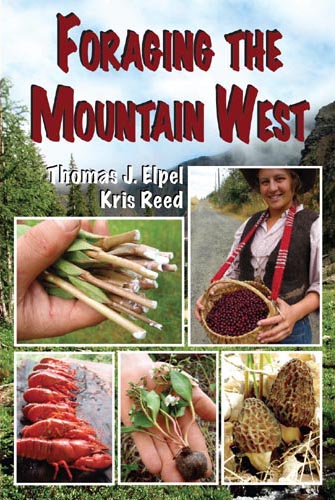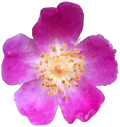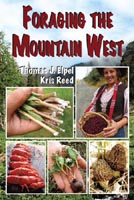
Onagraceae
Plants of the
Evening Primrose Family
The delicate flowers of this family have regular, bisexual flowers with 4 separate sepals and 4 separate petals (rarely 2, 3 or 5 of each). There are an equal number or twice as many stamens as petals. The ovary is positioned inferior, within a floral cup (hypanthium). The ovary consists of 4 (rarely 2 or 5) united carpels with the partition walls present, forming an equal number of chambers. The stigma is a distinctive feature of many species, with as many lobes as there are carpels in the ovary (usually 4). The ovary matures as a capsule with many seeds, or sometimes as a berry or drupe (a fleshy fruit with a stony pit). Worldwide, there are 20 genera and 650 species, including 12 genera in North America. The ornamental Fuchsia and Lopezia are members of this family. The plants of this family are mostly edible, with astringent, mucilaginous and antispasmodic properties.
Key Words: Flower parts usually in fours, including a four-lobed stigma.
Botany in a Day: The Patterns Method of Plant Identification is used worldwide as an aid to plant identification and keying out plant families. The Key to Genera of the Rocky Mountains featured below was created by the author towards the goal of creating a user-friendly flora for this particular bioregion. Photos were taken by the author, and include some species beyond the Rockies. Please e-mail Thomas J. Elpel to report mistakes or to inquire about purchasing high resolution photos of these plants.
Key to Genera in the Rocky Mountains
Read through the options and pick the closest match(es).
Additional genera are included at the bottom of the page.
Flower parts in 2s.
Small flowers with fuzzy sepals and white petals: Circaea
Flower parts in 4s. Stigma with 4 lobes.
Flowers yellow. Plant is woody at the base, a subshrub: Calyophus
Flowers yellow or white to pink. Sepals often folded back: Oenothera
Flowers white to pink. Petals distinctly 2-lobed. Capsule contains fuzzy hairs: Epilobium
Flowers white to pink. Petals deeply tapered at the base. Flowers asymmetrical: Gaura
Flowers pink to purple. Petals two-colored, spotted, and/or deeply lobed: Clarkia
Flowers pink to purple. Sepals petal-like. Capsule contains fuzzy hairs: Chamerion
Flower parts in 4s. Stigma lacking obvious lobes.
Flowers yellow. Stigma ball-like: Camissonia
Flowers white. 2-chambered ovary. Delicate plants: Gayophytum
Suncups: Camissonia
Return to Key


Camissonia multijuga. Froststem suncup. Photographed at Lake Mead National Recreation Area. Map source: U.S.Department of Agriculture. |


Camissonia breviflora. Few-Flower Evening Primrose. Photographed at Ruby Reservoir, near Alder, Montana.
This is a perennial plant with a starchy taproot. It is common in clay soils with receding dampness, such as in the mudflats around a reservoir. The plant has simple, long, basal leaves that are deeply dissected. The flowers are solitary or few in number, with 4 separate sepals, 4 separate petals, and 8 stamens. The stigma is ball-like, but still visibly 4-parted. The ovary matures as a capsule with many seeds. | |
Groundsmoke: Gayophytum
Return to Key
Evening Primrose: Oenothera
Return to Key

Oenothera caespitosa. Evening Primrose. This is a perennial plant with a starchy taproot. It is common in arid prairies and deserts. The plant has simple, oblong, basal leaves that are coarsely serrated. The flowers are solitary or few in number, with 4 separate sepals, 4 separate petals, and 8 stamens. The pistil has a deeply divided 4-parted stigma. The ovary matures as a capsule with many seeds. |
 Oenothera caespitosa. Evening Primrose. Arizona.

Map source: U.S.Department of Agriculture. |


Oenothera flava. Yellow Evening Primrose. This is a perennial plant with a starchy taproot. It is common in arid prairies and deserts. The plant has simple, lance-shaped, basal leaves. The leaf margin varies from smooth to dissected. The flowers arise from individual stems with 4 separate sepals, 4 separate petals, and 8 stamens. The pistil has a deeply divided 4-parted stigma. The ovary matures as a capsule with many seeds.Map source: U.S.Department of Agriculture. |  Oenothera sp. Evening Primrose. Chatfield State Park. Denver, Colorado. |

Oenothera villosa. Hairy Evening Primrose. This is a biennial plant with a starchy taproot. It is common along roadsides. The plant has simple, lance-shaped, allternate leaves. The flowers arise from the leaf axils, with 4 separate sepals, 4 separate petals, and 8 stamens. The pistil has a deeply divided 4-parted stigma. The ovary matures as a capsule with many seeds. This species is similar in appearance to O. biennis. |  Oenothera villosa. Hairy Evening Primrose.

Map source: U.S.Department of Agriculture. |

Oenothera pallida. Pale Evening Primrose. Photographed at Grand Staircase-Escalante National Monument. Utah. This is a perennial plant common in the arid West. The plant has simple, linear, alternate leaves. The flowers arise from the leaf axils, with 4 separate sepals, 4 separate petals, and 8 stamens. The pistil has a deeply divided 4-parted stigma. The ovary matures as a capsule with many seeds.
|
 Oenothera pallida. Pale Evening Primrose. Wyoming.

Map source: U.S.Department of Agriculture. |
Fireweed: Chamerion
Return to Key

Chamerion angustifolium.
(Formerly Epilobium angustifolium.) Fireweed. This is a perennial plant adapted to widely varying habitats from full sun to somewhat shady, and moist to dry. It is especially known as a colonizer of bare ground in the mountains, such as after a forest fire. The plant has simple, linear, alternate leaves. The flowers have 4 separate sepals that are pink and somewhat petal-like, plus 4 separate petals, and 8 stamens. The pistil has a noticeably 4-parted stigma. The ovary matures as a long, thin capsule filled with silky hairs and seeds.
|  Chamerion angustifolium.
(Formerly Epilobium angustifolium.) Fireweed.

Map source: U.S.Department of Agriculture. |
Willow Herb: Epilobium
Return to Key
 Epilobium sp. Willow Herb. Epilobium sp. Willow Herb. |  Epilobium sp. Willow Herb. |
Beeblossom: Gaura
Return to Key

Gaura coccinea. Scarlet Beeblossom. This is a perennial plant common in the arid West. The plant has simple, linear, alternate leaves. The butterfly-like irregular flowers have 4 separate sepals, 4 separate petals, and 8 stamens. The pistil has a noticeably 4-parted stigma. The ovary matures as a capsule. |
 Gaura coccinea. Scarlet Beeblossom.

Map source: U.S.Department of Agriculture. |
 Gaura parviflora. Smallflower Gaura. Also known as Gaura mollis. |
 Gaura parviflora. Smallflower Gaura. |
Clarkia: Clarkia
Return to Key

Clarkia unguiculata. Elegant Clarkia. This beautiful annual plant is native to California, but sometimes planted in roadside highway mixes elsewhere. The plant has simple, lance-shaped, alternate leaves. The flowers have 4 separate petal-like sepals, 4 separate petals, and 8 stamens. The pistil has a fuzzy 4-parted stigma. The ovary matures as a capsule. |
 Clarkia unguiculata. Elegant Clarkia.

Map source: U.S.Department of Agriculture. |


Clarkia pulchella. Pink Fairies. This intriguing flower is widespread in the northwestern states, but not necessarily common. It is an annual plant with simple, linear, alternate leaves. The flowers have 4 sepals which are united at the tip, often opening to one side, such that the sepals remain united and appear much like a bract beneath the flower. There are 4 separate, deeply lobed petals, and 8 stamens in two series, short and tall. The pistil has a noticeably 4-parted stigma. The ovary matures as a capsule. Map source: U.S.Department of Agriculture. | 
Foraging the Mountain West |
Also in the Evening Primrose Family
 Calylophus serrulatus. Yellow Suncups. |
 Calylophus serrulatus. Yellow Suncups. Tongue River, Montana. |

Fuchsia boliviana. Bolivian Fuchsia. Bolivian Fuchsia is native to Argentina, Peru, and Bolivia. |
 Fuchsia sp. Fuchsia. |

Ludwigia grandiflora. Large-Flower Primrose Willow. Introduced. |
 Ludwigia grandiflora. Large-Flower Primrose Willow. Five petals are uncommon in the Evening Primrose family. |
There are more
Evening Primrose Family pictures
at PlantSystematics.org.
Return to the Plant Families Index
Return to the Wildflowers & Weeds Home Page
|

























 Epilobium sp. Willow Herb.
Epilobium sp. Willow Herb.





















